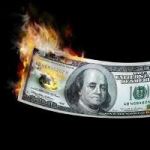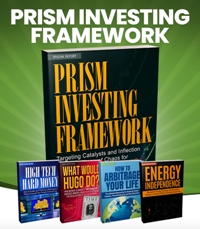 “You put the lime in the coconut, you drank ‘em both up.”
“You put the lime in the coconut, you drank ‘em both up.”
– Coconut, Harry Nilsson
Breakdown and Reordering of Trade
The breakdown and reordering of global trade via President Trump’s tariff policies will have many consequences. Long established trade relationships come with mutual dependency. Abruptly severing or restricting these ties will yank the rug out from under how people the world over pursue their livelihoods.
America imports and consumes massive amounts of goods and products Made in China and other Asian countries. Trump’s trade tariffs put the export driven economic models of these countries at extreme risk.
America accounts for over 30 percent of the world’s consumer spending. Should tariffs limit the ability for countries to export goods to America, they will be left with a massive supply glut. Thus, they will have two options: Increase domestic consumption. Or decrease production.
Certainly, it is more favorable for these countries to increase their domestic consumption. The alternative is widespread layoffs, skyrocketing unemployment, and a deep recession. But increasing consumption is easier said than done.
Not everyone is trained to work all week and then shop ‘til you drop on weekends. In some countries, people have a cultural aversion to spending money on things that are above and beyond basic necessities. Appearing humble to friends and neighbors is more important than indulging in luxury goods and flaunting wasteful consumption.
The personal savings rate in China, for example, is 45.9 percent, while in America it’s 3.6 percent. In other words, people in China have a rate of savings that is over 12 times more than their counterparts in America.
The consumer potential in China is huge compared to actual consumption. But it is locked up by historic cultural inclinations.
So, if China can no longer sell exports to America, and they cannot make up for this with domestic consumption, they will be forced to decrease production.
This Is Different
As a percent of GDP, exports account for about 20 percent of China’s economy. In the U.S., by comparison, exports account for about 11 percent of the economy. Nonetheless, China’s reliance on exports could be much worse.
In Vietnam, for example, exports as a percent of GDP account over 87 percent of its economy. The loss of the American consumer will affect both China and Vietnam. However, the impact will be greater to Vietnam.
The tariff directed breakdown and reordering of trade will also impact the USA. Trump believes the reordering will be to the advantage of working Americans. Even if this were true, it would take a decade or more to occur. In the meantime, you can expect a recession – or two – within the American economy.
During JPMorgan Chase’s recent first-quarter earnings call, CEO Jamie Dimon put the odds of a recession in the United States at a 50-50-coin flip. You know the reasons as well as Dimon.
Trade wars, persistent inflation, and fiscal deficits were some of the concerns he noted. When asked how the current economic and political situation compares to the past, Dimon remarked that this time is different:
“This is different. This is the global economy. The most important thing to me is the Western world stays together economically, when we get through all this, and militarily, to keep the world safe and free for democracy. That is the most important thing.”
The difference Dimon is referring to is Trumpism. Trump is attempting to restructure the economic framework so that America can renew its focus and put America first. For Trump, keeping the Western world together economically and militarily is a secondary concern.
Trumpism
The rationale for Trumpism was outlined by Secretary of State Marco Rubio during his Senate confirmation hearing on January 15, 2025. Here is an excerpt of what he said:
“Out of the triumphalism of the end of the Cold – long Cold War emerged a bipartisan consensus, and this consensus was that we had reached the end of history, that all of the nations of the world would now become members of the democratic Western-led community; that a foreign policy that served the national interest could now be replaced by one that served the liberal world order; and that all mankind was now destined to abandon national sovereignty and national identity and would instead become one human family and citizens of the world. This wasn’t just a fantasy. We now know it was a dangerous delusion.
“Here in America and in many of the advanced economies across the world, an almost religious commitment to free and unfettered trade at the expense of our national economy shrunk the middle class, left the working class in crisis, collapsed our industrial capacity, and has pushed critical supply chains into the hands of adversaries and of rivals.”
Rubio’s words summarize the guiding beliefs that are shaping policies under Trumpism. They also put context into Trump’s recent trade tariff policies.
Yet, while Trumpism adequately diagnoses the challenges America faces, the solution that’s being attempted is off the mark. Trump’s tariff policies do not recognize the role that government deficits, which are made possible through limitless credit creation, have in perpetuating the trade imbalances. Nor do they address China’s currency manipulation tactics.
Trumpism and the Fading Dollar
The trade deficit, in and of itself, is not the issue. The issue is that the trade deficit runs wild without restraint because of infinite credit creation, which is only possible with fiat currencies.
Trumpism seeks to correct the symptoms of trade imbalances on the back end with tariffs rather than snuffing them out at the root cause with honest money and a balanced budget. Without honest money and a balanced budget, all attempts to correct the trade distortions are pointless. On the whole, they may make things worse.
Trump’s initial efforts with Elon Musk and DOGE were on the right track. Cutting government spending and eliminating the deficit are practical steps towards reducing the trade deficit.
But Trump’s recent actions are contrary. Just last week, while tariff madness was going on, he proposed the first ever $1 trillion defense spending budget. This guarantees the budget deficit for fiscal year 2025 will be over $2 trillion.
Inevitably, all fiat currencies eventually reach the end of the road. For the U.S. dollar, the end of the road is now within sight. Foreign central banks and governments see what’s coming. The dollar index has slipped below 100. The price of gold has pushed above $3,300 per ounce. These are signs of an approaching crackup.
How will this all play out in the months ahead?
Will the U.S. dollar crash and burn like countless other fiat currency collapses throughout history?
Will the Federal Reserve and the big banks collude to prop up the system through heavy handed schemes of market intervention, thus elongating the demise?
Will leadership throw the 112-year experiment with fiat money out the window and return to sound money – gold and silver – as defined by the Constitution?
Your guess is as good as ours. Regardless, you can count on plenty of chaos and destruction ahead.
[Editor’s note: Have you ever heard of Henry Ford’s dream city of the South? Chances are you haven’t. That’s why I’ve recently published an important special report called, “Utility Payment Wealth – Profit from Henry Ford’s Dream City Business Model.” If discovering how this little-known aspect of American history can make you rich is of interest to you, then I encourage you to pick up a copy. It will cost you less than a penny.]
Sincerely,
MN Gordon
for Economic Prism
Return from Trumpism and the Fading Dollar to Economic Prism





Absolutely spot on. The core issue is Triffin’s Dilemma. I see a monetary crisis/reset coming as Rickard’s often discusses. He also mentioned the IMF-SDR as a candidate to solve the dilemma and I think this is also related to the BIS Tier 1 gold mandate to reprice and anchor the basket currency. SDR bonds have been issued and even talk of converting US bonds to SDR bonds. This does not bode well for US imperialism or American First agenda. The Trump team is way off base blaming others for our own debt and spending, financialization and exporting our inflation. We have been ripping off the world with devaluation and soon uncreditworthiness. An indebted consumer economy does not have a comparative advantage and China exports to the US is a mere 13% or 2.9% of their GDP. If you listen to Fox, Lutnik or Navarro you would think it is 87%! Hunker down and keep up the good work.
You gave a gloomy scenario for China and Vietnam if their exports to the US stop
But what happens to the US when the cheap consumer goods stop coming in? Wil the shekves of Walmart, Target, Costco and Home Depot be empty?
Firmes Con’ Trump!